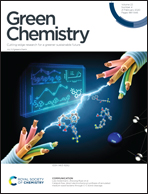Mechanistic insights into the lignin dissolution behaviors of a recyclable acid hydrotrope, deep eutectic solvent (DES), and ionic liquid (IL)†
Abstract
Currently, recyclable acid hydrotropes (p-TsOH), deep eutectic solvents (DES, ChCl-Lac), and ionic liquids (IL, [Amim][Cl]) are receiving increasing attention due to their superior delignification performance. However, very few mechanistic studies have shed light on the questions of how these solvents achieve the rapid dissolution of lignin and why they exhibit dramatic differences in the lignin removal. In this study, we first developed a comparative study of their delignification capacities. Under the same pretreatment temperature of 80 °C, three solvents exhibited a remarkable difference in the lignin removal: p-TsOH hydrotrope (86%, 1.5 h) > ChCl-Lac (11%, 15 h) > [Amim][Cl] (0%, 15 h). The extracted lignin samples were characterized via FTIR, TGA, 31P NMR, and 2D HSQC NMR spectroscopy to evaluate their structural properties. Moreover, mechanistic insights into the differences in lignin removal were analyzed via combined quantum chemistry (QC) calculations and molecular dynamics (MD) simulations. The results indicated that both C–H⋯π and strong H-bonding interactions contribute to the highest interaction energy (ΔE = 15.11 kcal mol−1) between p-TsOH hydrotrope and VG, which resulted in the high lignin removal.



 Please wait while we load your content...
Please wait while we load your content...